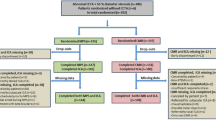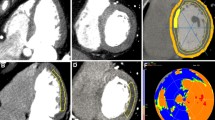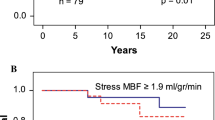Abstract
Purpose
Coronary revascularisation is the treatment of choice in patients with stable angina who have significant stenoses. From a pathophysiological point of view, however, mitigation of angina is to be expected only in the presence of reversible ischaemia. Therefore it was the aim of this study to examine the effect of revascularisation on stable angina in relation to the myocardial perfusion imaging (MPI) pattern prior to intervention.
Methods
Three hundred and eighty-four patients (58.0±8.8 years) referred for angiography underwent MPI. Prior to MPI and at 2-year follow-up, patients were classified as having typical angina, atypical angina, non-cardiac chest pain or no pain, and the severity of chest pain was graded according to the Canadian Cardiovascular Society (CCS) criteria. The patients themselves estimated their pain on a visual analogue scale. Management was based on symptoms and angiographic findings, since the results of MPI were not communicated.
Results
Among the 240 patients who were not revascularised, 79% had typical or atypical angina at study entrance versus 40% at follow-up. In comparison, 93% of the 144 revascularised patients had typical or atypical angina before intervention versus only 36% at follow-up. This additional advantage of invasive therapy was present only in patients with reversible defects; revascularisation had no additional effect in patients with normal perfusion or irreversible defects. Similarly, additional, significant reductions in CCS class and visual analogue score were observed exclusively in patients with reversible defects.
Conclusion
In patients referred for coronary angiography owing to known or suspected stable angina, revascularisation was significantly more effective than medical treatment exclusively in patients with reversible ischaemia.



Similar content being viewed by others
References
Gibbons RJ, Abrams J, Chatterjee K, Daley J, Deedwania PC, Douglas JS, et al. ACC/AHA 2002 guideline update for the management of patients with chronic stable angina: a report of the American College of Cardiology/American Heart Association Task Force on Practice Guidelines (Committee to Update the 1999 Guidelines for the Management of Patients with Chronic Stable Angina). 2002. (Accessed at December 31, 2004 at http://www.acc.org/clinical/guidelines/stable/stable_clean.pdf.)
Johansen A, Høilund-Carlsen PF, Christensen HW, Grupe P, Veje A, Vach W, et al. Observer variability in the evaluation of dual isotope Tl-201/Tc-99 m-sestamibi rest/stress myocardial perfusion SPECT in males and females with known or suspected stable angina pectoris. J Nucl Cardiol 2004;11:710–8.
Diamond GA, Forrester JS. Analysis of probability as an aid in the clinical diagnosis of coronary-artery disease. N Engl J Med 1979;300:1350–8.
Diamond GA. A clinically relevant classification of chest discomfort. J Am Coll Cardiol 1983;1:574–5.
Campeau L. Grading of angina pectoris. Circulation 1976;54:5223.
Saunamäki K, Egstrup K, Mickley H, Nielsen JR, Schnohr P, Thomassen AR. Guidelines for exercise-testing in ischemic heart disease. Danish Society of Cardiology, Copenhagen; 1995.
Berman DS, Kiat H, Friedman JD, Wang FP, van-Train K, Matzer L, et al. Separate acquisition rest thallium-201/stress technetium-99m sestamibi dual-isotope myocardial perfusion single-photon emission computed tomography: a clinical validation study. J Am Coll Cardiol 1993:22:1455–64.
Anonymous. Eleven-year survival in the Veterans Administration randomized trial of coronary bypass surgery for stable angina. The Veterans Administration Coronary Artery Bypass Surgery Cooperative Study Group. N Engl J Med 1984;311:1333–9.
Anonymous. Eighteen-year follow-up in the Veterans Affairs Cooperative Study of Coronary Artery Bypass Surgery for stable angina. The VA Coronary Artery Bypass Surgery Cooperative Study Group. Circulation 1992;86:121–30.
Yusuf S, Zucker D, Peduzzi P, Fisher LD, Takaro T, Kennedy JW, et al. Effect of coronary artery bypass graft surgery on survival: overview of 10-year results from randomised trials by the Coronary Artery Bypass Graft Surgery Trialists Collaboration. Lancet 1994;344:563–70.
Anonymous. Seven-year outcome in the Bypass Angioplasty Revascularization Investigation (BARI) by treatment and diabetic status. J Am Coll Cardiol 2000;35:1122–9.
Anonymous. Coronary artery bypass surgery versus percutaneous coronary intervention with stent implantation in patients with multivessel coronary artery disease (the stent or surgery trial): a randomised controlled trial. Lancet 2002;360:965–70.
Alderman EL, Bourassa MG, Cohen LS, Davis KB, Kaiser GG, Killip T, et al. Ten-year follow-up of survival and myocardial infarction in the randomized coronary artery surgery study. Circulation 1990;82:1629–46.
Peduzzi P, Kamina A, Detre K. Twenty-two-year follow-up in the VA Cooperative Study of Coronary Artery Bypass Surgery for Stable Angina. Am J Cardiol 1998;81:1393–9.
Hueb WA, Soares PR, Almeida DO, Arie S, Cardoso RH, Wajsbrot DB, et al. Five-year follow-up of the medicine, angioplasty, or surgery study (MASS): a prospective, randomized trial of medical therapy, balloon angioplasty, or bypass surgery for single proximal left anterior descending coronary artery stenosis. Circulation 1999;100:II107–13.
Bucher HC, Hengstler P, Schindler C, Guyatt GH. Percutaneous transluminal coronary angioplasty versus medical treatment for non-acute coronary heart disease: meta-analysis of randomised controlled trials. BMJ 2000;321:73–7.
Espinola-Klein C, Rupprecht HJ, Erbel R, Nafe B, Brennecke R, Meyer J. Ten-year outcome after coronary angioplasty in patients with single-vessel coronary artery disease and comparison with the results of the coronary artery surgery study (CASS). Am J Cardiol 2000;85:321–6.
Høilund-Carlsen PF, Amtorp O. Thirty years of coronary revascularization in stable angina pectoris. Results of randomised controlled trials. Ugeskr Laeger 2000;162:3443–9.
Parisi AF, Folland ED, Hartigan P. A comparison of angioplasty with medical therapy in the treatment of single-vessel coronary artery disease. Veterans Affairs ACME Investigators. N Engl J Med 1992;326:10–6.
Anonymous. Five-year clinical and functional outcome comparing bypass surgery and angioplasty in patients with multivessel coronary disease. A multicenter randomized trial. Writing Group for the Bypass Angioplasty Revascularization Investigation (BARI) Investigators. JAMA 1997;277:715–21.
Henderson RA, Pocock SJ, Clayton TC, Knight R, Fox KA, Julian DG, et al. Seven-year outcome in the RITA-2 trial: coronary angioplasty versus medical therapy. J Am Coll Cardiol 2003;42:1161–70.
Pocock SJ, Henderson RA, Rickards AF, Hampton JR, King SB III, Hamm CW, et al. Meta-analysis of randomised trials comparing coronary angioplasty with bypass surgery. Lancet 1995;346:1184–9.
Dzavik V. New frontiers and unresolved controversies in percutaneous coronary intervention. Am J Cardiol 2003;91:27A–33A.
Anonymous. Guidelines and indications for coronary artery bypass graft surgery. A report of the American College of Cardiology/American Heart Association Task Force on Assessment of Diagnostic and Therapeutic Cardiovascular Procedures (Subcommittee on Coronary Artery Bypass Graft Surgery). J Am Coll Cardiol 1991;17:543–89.
Patel DJ, Mulcahy D, Norrie J, Wright C, Clarke D, Ford I, et al. Natural variability of transient myocardial ischaemia during daily life: an obstacle when assessing efficacy of anti-ischaemic agents? Heart 1996;76:477–82.
Berman DS, Germano G, Shaw LJ. The role of nuclear cardiology in clinical decision making. Semin Nucl Med 1999;29:280–97.
Hachamovitch R. Risk assessment of patients with known or suspected CAD using stress myocardial perfusion SPECT. Part I: the ongoing evolution of clinical evidence. Rev Cardiovasc Med 2000;1:91–102.
Thomas GS, Miyamoto MI, Morello AP III, Majmundar H, Thomas JJ, Sampson CH, et al. Technetium 99m sestamibi myocardial perfusion imaging predicts clinical outcome in the community outpatient setting. The Nuclear Utility in the Community (NUC) study. J Am Coll Cardiol 2004;43:213–23.
Hachamovitch R, Hayes SW, Friedman JD, Cohen I, Berman DS. Stress myocardial perfusion single-photon emission computed tomography is clinically effective and cost effective in risk stratification of patients with a high likelihood of coronary artery disease (CAD) but no known CAD. J Am Coll Cardiol 2004;43:200–8.
Pagley PR, Beller GA, Watson DD, Gimple LW, Ragosta M. Improved outcome after coronary bypass surgery in patients with ischemic cardiomyopathy and residual myocardial viability. Circulation 1997;96:793–800.
Morse RW, Noe S, Caravalho J Jr, Balingit A, Taylor AJ. Rest-redistribution 201-Tl single-photon emission CT imaging for determination of myocardial viability: relationship among viability, mode of therapy, and long-term prognosis. Chest 1999;115:1621–6.
Di Carli MF, Hachamovitch R, Berman DS. The art and science of predicting postrevascularization improvement in left ventricular (LV) function in patients with severely depressed LV function. J Am Coll Cardiol 2002;40:1744–7.
Allman KC, Shaw LJ, Hachamovitch R, Udelson JE. Myocardial viability testing and impact of revascularization on prognosis in patients with coronary artery disease and left ventricular dysfunction: a meta-analysis. J Am Coll Cardiol 2002;39:1151–8.
Høilund-Carlsen PF, Johansen A, Christensen HW, Pedersen LT, Jøhnk IK, Vach W, et al. The usefulness of the exercise electrocardiogram in diagnosing ischemic or coronary heart disease in patients with chest pain. Am J Cardiol 2005;95:96–9.
Christensen HW, Vach W, Haghfelt T, Høilund-Carlsen PF. Observer reproducibility of cardiovascular classification systems for stable angina pectoris and cardiac functional status. J Nucl Cardiol 2003;10:S65 (abstract).
Acknowledgements
The Danish Heart Foundation, The Novo Nordisk Foundation, The University of Southern Denmark and NORDUnet supported the study financially.
Author information
Authors and Affiliations
Corresponding author
Rights and permissions
About this article
Cite this article
Johansen, A., Høilund-Carlsen, P.F., Christensen, H.W. et al. Use of myocardial perfusion imaging to predict the effectiveness of coronary revascularisation in patients with stable angina pectoris. Eur J Nucl Med Mol Imaging 32, 1363–1370 (2005). https://doi.org/10.1007/s00259-005-1799-7
Received:
Accepted:
Published:
Issue Date:
DOI: https://doi.org/10.1007/s00259-005-1799-7




